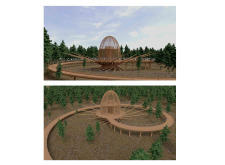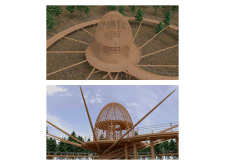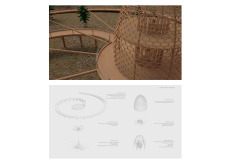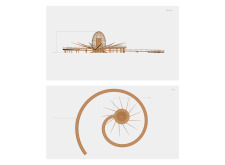5 key facts about this project
The design presents a multi-level structure that is both functional and integrated into its natural setting. Surrounded by trees, the building focuses on accessibility and fosters a connection between its internal spaces and the environment. The overall concept strives to blend the built form with the landscape while catering to the needs of its users.
Foundation and Framework
The project begins with a strong main foundation, providing necessary stability. Wooden pillars extend upward, delivering vital support for the structure above. A notable feature is the wooden hyperboloid of revolution, which adds an interesting shape while also ensuring structural strength. This form reflects natural shapes, enhancing the project’s visual appeal.
Levels and Spatial Dynamics
The first and second levels are crafted from timber, creating a warm atmosphere throughout. On the first level, a frame shell is used, giving a sense of openness and promoting interaction among users. The second level builds on this idea, adding more space and contributing to the design’s overall aesthetics. The use of timber in both levels aligns the structure with the natural surroundings.
Accessibility and Circulation
A key element of the design is the wooden gangway that connects the different levels through a spiral access point. This feature makes movement easy and convenient for everyone, regardless of mobility. Special attention has been given to security railings that accommodate disabled users, reinforcing a commitment to accessibility. The spiral stairs and railings tie together the different levels while enhancing the design’s overall coherence.
Geometric Patterns and Assembly
The assembly highlights a unique pattern made from timber hexagons, showcasing a modern approach to structure and design. This geometric arrangement not only supports the building but also adds an artistic dimension. Elevation and plan views reveal how this distinctive structure interacts with the landscape, emphasizing the connection between architecture and nature.
Wooden elements throughout the design create a warm and inviting atmosphere, resulting in a practical yet visually appealing connection to the surrounding environment.






















































